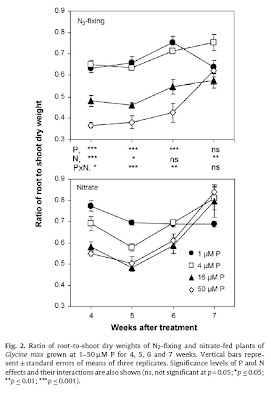 When plants find themselves in low phosphorus soil, they have evolved many adaptations that I have not had the chance to discuss yet. Some of these include increased root surface area, decreased rhizosphere pH and increased root exudation of carboxylates.
When plants find themselves in low phosphorus soil, they have evolved many adaptations that I have not had the chance to discuss yet. Some of these include increased root surface area, decreased rhizosphere pH and increased root exudation of carboxylates.I am always hearing in the media and in scientific journals how wonderful the soybean is and how it will one day save our croplands. I posted a video below so you can see what I am talking about.
I get it, it's important, but is it really that special?
 Now let’s step back for a second and think about the soybean. It is a legume crop that is reliant on N2 fixation. This fixation involves an increase in cation absorption and a release of protons at the root to compensate for the positive charges when they are in phosphorus rich soil. The opposite interaction occurs when they are in nitrate rich soil.
Now let’s step back for a second and think about the soybean. It is a legume crop that is reliant on N2 fixation. This fixation involves an increase in cation absorption and a release of protons at the root to compensate for the positive charges when they are in phosphorus rich soil. The opposite interaction occurs when they are in nitrate rich soil. A research group in Australia had this exact idea last spring. They wanted to see what effects low phosphorus may have on the release of protons/hydroxyl ions and carboxylates in soybeans either reliant on N2 fixation or supplied with nitrate. From there, they wanted to study if root exudation was important in phosphorus acquisition.
The authors of this article, Dr. Tang and her colleagues, went on to explain the methods of the above study. Now to say the method section is short and sweet would be quite an understatement. However, if you actually read this small section, it is full of everything you could want to know. They covered how the total amounts of H+/OH- was calculated and how the plants were grown. They discussed how they decided on statistical significance and what programs they even used to perform these calculations.
Plants were either reliant on N2 fixation or supplied with nitrate and were grown in nutrient solution with a varied level of phosphorus for weeks. The release of protons and carboxylates from roots was measured. All of this data was combined and analyzed.
The results of this paper showed some mind-blowing results!
They found that unlike other plants, soybeans decreased proton release per unit root biomass when in low phosphorus conditions. This is evident from the table above. They also increased the release of hydroxyl ions when they were fed with nitrate. Low phosphorus seemed to decrease the uptake of K, Ca, Mg, S, and Cl, but it increased nitrate uptake per unit root biomass. An increase of carboxylates was observed in low phosphorus environments. Soybean in the low phosphorus conditions also seemed to increase root/shoot ratio, which can be seen in the figure to the left.
A pretty exciting conclusion that can be drawn from this research is that soybeans display some pretty amazing strategies to deal with low phosphorous. They are able to acquire phosphate through a decrease in proton release, which favors phosphate mobilization in acid soils. They also increase the surface area for these protons to be released by increasing root-to-shoot ratio and specific root length.
Despite these significant results, the authors of this paper are quick to point out there is more research that still needs to be done. We need to discover if a decrease in proton release of soybeans in low phosphorus conditions would still favor phosphate acquisition if they were grown in much more acidic soils.
Ok soybean, I have to say that is pretty cool. Imagine other crops such as corn or rice decreasing their proton release and mobilizing phosphate from the soil. My blog would basically become obsolete.
My favorite part of this paper comes at the end when they discuss reasons for discrepancies between this paper and previous studies. They discuss that the duration of phosphate removal in previous studies was done over days, while this study was done over 4 or 5 weeks. The authors of this study also discussed how research, plants were grown at pH 4.5, the conditions set for studying Al toxicity.
In this present study, the solution pH was kept between 5 and 6.
It is very rare to see such a thorough discussion of differences that exist between studies. The researchers of this paper were able to anticipate the criticism they may receive, and address it directly.
So let’s invest some time and money into soybeans… and see what else these little guys are capable of!
Reference
Tang, C. Han, Z. Qiao, Y and Zheng J. 2009. Phosphorus deficiency does not enhance proton release by roots of soybean [Glycine max (L.) Murr.]. Envt and Exp Botany, 67, 28–234.


No comments:
Post a Comment